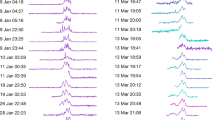Play all audios:

ABSTRACT MOST extra-galactic radio sources have a spectrum which over a limited frequency range is of the form _S_αν−α, where _S_ is the flux density and ν is the frequency. The spectral
index α is usually constant over a considerable frequency range, which implies a straight spectrum when plotted logarithmically, the average value over all sources being 0.75 with a range
from about 0.2 to 1.3. For some sources, however, α changes slowly with frequency with the result that the spectra are concave or convex1–3. It is believed that the radiation is produced by
the synchrotron mechanism, where energy losses by the electrons can lead in time to an increase in the slope4,5 and where, in addition, different component sources may contribute to the
overall spectrum. High frequency observations by Dent and Haddock6 showed that two sources, 3_C_ 84 (NGC 1275, a Seyfert galaxy) and 3_C_ 279 (a quasi-stellar source), have spectra which
decrease in flux density from about 38 MHz towards higher frequencies, but beyond 3,000 MHz the slope of the spectrum is positive. This suggested the presence of a small diameter component
which had a low frequency cut-off due to synchrotron self-absorption7 and stimulated a search for other sources with similar spectra. Kellermann (personal communication) has recently
observed fourteen sources with irregular spectra, of which some have a tendency towards these latter characteristics, but so far there have been no published spectra similar to 3_C_ 84 and
3_C_ 279. Recent observations at the frequencies of 3,200, 6,600 and 10,600 MHz, however, using the 150 foot telescope of the Algonquin Radio Observatory, when combined with the observations
by other observers8–11, have shown that the source 4_C_ 50.11/NRAO 150 is of this form but with the addition of two apparent peaks at frequencies of about 350 and 9,000 MHz. The source is
included in the list by Kellermann, but details of the characteristics failed to show up because of the omission of low frequency observations and the new measurements between 5,000 and
15,000 MHz. Access through your institution Buy or subscribe This is a preview of subscription content, access via your institution ACCESS OPTIONS Access through your institution Subscribe
to this journal Receive 51 print issues and online access $199.00 per year only $3.90 per issue Learn more Buy this article * Purchase on SpringerLink * Instant access to full article PDF
Buy now Prices may be subject to local taxes which are calculated during checkout ADDITIONAL ACCESS OPTIONS: * Log in * Learn about institutional subscriptions * Read our FAQs * Contact
customer support SIMILAR CONTENT BEING VIEWED BY OTHERS A RADIO TRANSIENT WITH UNUSUALLY SLOW PERIODIC EMISSION Article 26 January 2022 ASTROPHYSICAL CONSTRAINTS FROM THE SARAS 3
NON-DETECTION OF THE COSMIC DAWN SKY-AVERAGED 21-CM SIGNAL Article 28 November 2022 ON THE DETECTION OF A COSMIC DAWN SIGNAL IN THE RADIO BACKGROUND Article 28 February 2022 REFERENCES *
Conway, R. C., Kellermann, K. I., and Long, R. J., _Mon. Not. Roy. Astro. Soc._, 125, 261 (1963). Article ADS Google Scholar * Kellermann, K. I., _Ap. J._, 140, 969 (1964). Article ADS
Google Scholar * Dent, W. A., and Haddock, F. T., _Ap. J._, 144, 568 (1966). Article ADS Google Scholar * Kardashev, N. S., _Sov. Ast. A-J._, 8, 217 (1962). ADS Google Scholar *
Kellermann, K. I., _Ap. J._, 146, 621 (1966). Article ADS CAS Google Scholar * Dent, W. A., and Haddock, F. T., _Nature_, 205, 487 (1965). Article ADS Google Scholar * Slish, V. I.,
_Nature_, 199, 682 (1963). Article ADS Google Scholar * Williams, P. J. S., Kenderdine, S., and Baldwin, J. E., _Mem. Roy. Astro. Soc._, 70, 53 (1966). ADS Google Scholar * Gower, J. F.
R., Scott, P. F., and Wills, D., _Mem. Roy. Astro. Soc._, 71, 49 (1967). ADS Google Scholar * Howard, W. E., and Moran, S. P., _Ap. J. Suppl._, 10, 1 (1965). Article ADS Google Scholar
* Pauliny-Toth, I. I. K., Wade, C. M., and Heeschen, D. S., _Ap. J._ Suppl., 13, 65 (1966). ADS Google Scholar * Palmer, H. P., Rowson, B., Anderson, B., Donaldson, W., Miley, G. K.,
Gent, H., Adgie, R. L., Slee, O. B., and Crowther, J. H., _Nature_, 213, 789 (1967). Article ADS Google Scholar * Ryle, M., and Longair, M. S., _Mon. Not. Roy. Astro. Soc._, 136, 123
(1967). Article ADS Google Scholar Download references AUTHOR INFORMATION AUTHORS AND AFFILIATIONS * Radio Astronomy Group, Queen's University, Kingston, Ontario V. A. HUGHES &
R. V. POTTER Authors * V. A. HUGHES View author publications You can also search for this author inPubMed Google Scholar * R. V. POTTER View author publications You can also search for this
author inPubMed Google Scholar RIGHTS AND PERMISSIONS Reprints and permissions ABOUT THIS ARTICLE CITE THIS ARTICLE HUGHES, V., POTTER, R. Spectrum of the Radio Source 4_C_ 50.11/NRAO 150.
_Nature_ 217, 832–833 (1968). https://doi.org/10.1038/217832a0 Download citation * Received: 06 December 1967 * Issue Date: 02 March 1968 * DOI: https://doi.org/10.1038/217832a0 SHARE THIS
ARTICLE Anyone you share the following link with will be able to read this content: Get shareable link Sorry, a shareable link is not currently available for this article. Copy to clipboard
Provided by the Springer Nature SharedIt content-sharing initiative
